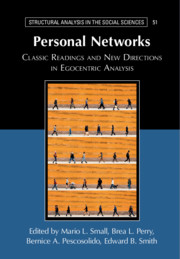Book contents
- Personal Networks
- Structural Analysis in the Social Sciences
- Personal Networks
- Copyright page
- Contents
- Figures
- Tables
- Contributors
- I Background
- II Early Foundations
- III Later Foundations
- IV New Perspectives
- 20 On Cognition
- 21 On Mobilization
- 22 On Trust
- 23 On Dynamics
- 24 On Inequality
- 25 On Culture
- 26 On Migration
- 27 On Movements
- 28 On Social Media
- Index
- Recent Books in the Series
- References
24 - On Inequality
The Context of Network Inequality
from IV - New Perspectives
Published online by Cambridge University Press: 01 October 2021
- Personal Networks
- Structural Analysis in the Social Sciences
- Personal Networks
- Copyright page
- Contents
- Figures
- Tables
- Contributors
- I Background
- II Early Foundations
- III Later Foundations
- IV New Perspectives
- 20 On Cognition
- 21 On Mobilization
- 22 On Trust
- 23 On Dynamics
- 24 On Inequality
- 25 On Culture
- 26 On Migration
- 27 On Movements
- 28 On Social Media
- Index
- Recent Books in the Series
- References
Summary
An individual’s network ties are crucial to their well-being and life outcomes, and an emerging literature connects these network effects to the persistence or mitigation of group-based inequality. At the same time, we know very little about how the contexts in which relationships are formed shape individual-level and group-level networks. This leaves our understanding of network-based mechanisms of inequality separate from the contexts in which relationships are formed and operate. This chapter sets forth a model that combines context, ego and global network structure, and inequality arising from network effects into one causal chain. We review evidence on how different characteristics of context – population size and composition, number and kinds of social foci, and organizational practices – contribute to the structure of social networks. We then review research demonstrating how those network features, as well as the overall structure of relationships, contribute to distributions of outcomes in the population. The chapter concludes with applications of the model using examples from student behavior in schools and from evidence about migration. We suggest that network scholars and scholars of inequality build this more expansive perspective into their work in order to better understand mechanisms of inequality.
- Type
- Chapter
- Information
- Personal NetworksClassic Readings and New Directions in Egocentric Analysis, pp. 630 - 650Publisher: Cambridge University PressPrint publication year: 2021
References
- 1
- Cited by

